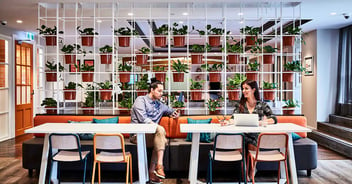The percentage of Australians working from home has jumped from eight per cent to forty per cent and productivity has endured. Many organisations have reimagined the way they operate which presents its own set of unique challenges. When implementing an effective hybrid workplace policy, striking the right balance between working remotely and in-office requires careful consideration.
The hybrid working model affords greater flexibility and freedom for staff but it’s essential that productivity, engagement levels, and inclusive working culture is maintained, in and out of the office.
There are many questions that employers have relating to hybrid workplace policy, implementing the right tech for efficient and effective workflow, and ensuring that productivity levels are upheld.
To help answer these questions we spoke with business and leadership expert Mandy Holloway. Mandy is the Co-founder and Owner of Courageous Leaders and her empathy-based approach to business leadership has helped mobilise different organisations to boldly rise to challenges and embrace them in their stride.
Through meaningful communication and understanding of employees, Mandy believes that organisations can inspire successful working environments, both face-to-face and virtually.
Striking the perfect balance – do what’s best for your company
When employers actively trust their staff, they are more likely to perform better. Mandy believes that leaders “have to embrace what it means to be a leader, which means empower people, trust people. You don’t need to see that someone’s sitting there to prove that they’re actually working.”
Policies for flexible working
The hybrid model is effective in future-proofing the workplace. Many studies conducted since the pandemic began show that working flexibility catalyses employee engagement, productivity, and positive wellbeing.
Organisations that welcome hybrid workplace models are more likely to retain staff through giving them the option to work from home or in the office, or even allowing them to modify work hours. What’s more, creating a safe office environment that adopts adequate social distancing is paramount for organisational leaders and promotes the health and safety of everyone in the office.
Incorporating flexibility into workplace policies by giving employees options provides them with a sense of empowerment. Through doing this, you’re “giving people accountability. So as a leader with responsibility, you want your people to take accountability for what you’re empowering them to achieve. There must be a high level of trust and belief from the top leadership team,” says Mandy.
The right tech to support staff and aid productivity and efficiency
Organisations need the right tools to successfully manage change. Staff will need support when implementing new technology into working practices and to revitalise collaborative working cultures.
Encouraging learning opportunities will give everyone the chance to understand the tools and tech they need whether they decide to work in or out of the office. It is essential for organisations to address any gaps in understanding the technology involved in creating seamless, hybrid working environments. It’s also critical to review existing tech and processes.
Employers need to ensure that every staff member has exactly what they need to work effectively and to organise or stagger their in-office working days, all the while supporting digital inclusion. For example, implementing flexible desk/space booking platforms helps to carve a smooth path to hybrid working for organisations.
The importance of change management in establishing a successful hybrid workplace
Change management is a work in progress. Once people have settled into the new way of work and balancing days in and out of the office, it’s important to evaluate the hybrid model’s impact to see how your organisation is tracking and to sustain the model’s long-term benefits.
Employers should consider the individual, team, and organisational impacts. Are staff able to successfully complete their work? Are teams able to communicate and collaborate easily? Are the organisational changes working as intended? What areas can be improved?
Mandy believes that change management is as much about processes, as it is about bringing compassion “as well as information to support staff to transition from where they are now to where they need to be in the future. This creates a safe and powerful team.”
“And as leaders, we need to lead people to be able to make the best decisions to create these outcomes.”
The future is here and now. Australian workplaces are transforming at a rapid pace and the significant changes that come with this historic time are testing the ability of organisations to tackle challenges. The changes are gaining momentum and that’s why being prepared is more crucial than ever.
So evolve, be open to transformation, and understand what the future of work means for everyone. Read our eBook: Wellness and Wellbeing in workplace design and strategy, to help you better navigate through these revolutionary times in the working world.







